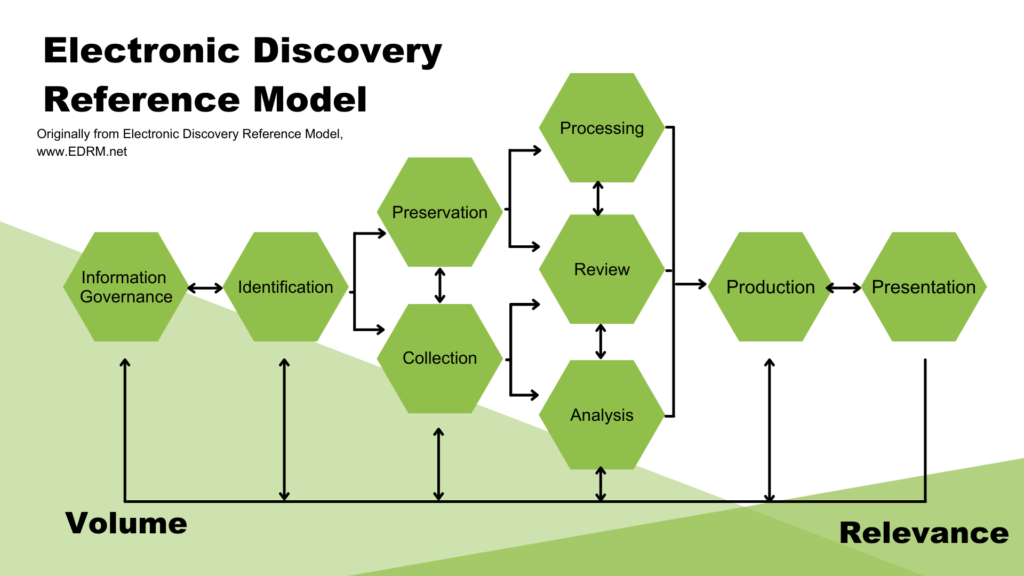Understanding the Stages of the EDRM (Electronic Discovery Reference Model)

The EDRM (Electronic Discovery Reference Model) refers to both a conceptual framework for understanding the stages within the overall eDiscovery process, and also the EDRM organization and community behind this framework and other resources.
The EDRM model consists of nine stages: information governance, identification, preservation, collection, processing, review, analysis, production, and presentation. It essentially serves as a map of the electronic discovery process from cradle to grave.
Stages of the EDRM
- Information Governance
While you may think that the process of eDiscovery would begin with the identification of potential data sources, it actually begins before that. In the information governance stage, the goal is to gain an understanding of an organizations data footprint and create a plan to control it from the point of creation to disposition. The purpose of information governance is to reduce exposure to risks and costs that through proactive efforts.
The EDRM has also created a separate model named the Information Governance Reference Model (IGRM) that covers this stage in depth, which you can find here.
- Identification
So, if information governance covered the management of all data, useful or not. The identification stage is the act of going through and identifying all potential sources of relevant information that may be relevant to your case. It’s during this stage when you begin evaluating the scope of the case, how many custodians might be involved, identifying what known data there is, where the potential ESI might be hiding, and so on.
Some examples of steps taken within the identification stage include conducting custodian interviews, talking to department heads to understands day-to-day data usage, and building out organizational data maps based on the information that was received.
- Preservation
Now that it’s been identified where the data is likely to be located, it’s time for the preservation stage. The goal of this stage is to ensure that evidence is preserved for use later on in the case. In order to maintain legal defensibility, once the duty to preserve is triggered, preservation should start early and be issued broadly to protect against any potentially relevant ESI from being altered or deleted. Examples of steps within the preservation stage include issuing a legal hold and implementing a data preservation plan.
- Collection
During the collection stage, data is forensically collected from web-based sources and physical devices to be evaluated during the review stage. Forensic collection can be on-site, fully-remote, or a hybrid model somewhere in between based on the technology used and workflows in place. During forensic collection, digital forensic examiners are able to defensibly collect and preserve information from conventional sources such as email and mobile devices, all the way to unconventional data sources such unstructured text data from social media conversations.
- Processing
It’s not always about how much data you have, but rather how you handle that data. The goal of the processing stage is to reduce the amount of data that is going to be reviewed. By doing this you are reducing the amount of time attorneys need to spend reviewing documents, which in turn reduces the document review cost and speeds up finding relevant documents by eliminating the noise. This is done through data filtering and culling. An example of this is de-NISTing and de-duplication of datasets before anything gets loaded into a review database. Another important role of processing is the preparation of data into a form that is capable for attorney review. This includes both native file processing and also file conversions.
- Review
During the review stage, data is hosted in an online review platform such as Relativity or Reveal and licensed attorneys review documents for relevance, privilege, document tagging, and other items relating to their case. It is also in this stage where reviewers can utilize TAR (Technology Assisted Review) and predictive coding to train machines to help them identify relevant information quicker. One benefit of TAR is the ability to run reviews where manual review wouldn’t have been possible, whether it’s because of sheer data size or tight review timelines.
- Analysis
While traditionally review and analysis are listed as separate stages, they are heavily intertwined and today’s technology allows reviewers to analyze concepts and context interspersed within the review stage. Examples of steps within the analysis stage include clustering topics together to identify frequent themes or analyzing communication patterns to identify who the key people are and what they were discussing. The analysis stage can be performed both within the review platform as well as within a eDiscovery processing tool such as Nuix.
8. Production
Following the review and analysis stage. The ESI needs to be produced to be used in litigation. This stage can include OCR on redacted production documents, applying EBS and annotations, converting files to useable formats, and delivering data via secure FTP.
9. Presentation
The last stage of the EDRM before data moves on to disposition is presentation. Words are not enough to sway a jury, particularly in a longer trial with several witnesses and large amounts of evidence. Adding visual aids to that story will help them to better understand the argument at hand. This stage is focused on presenting the digital evidence at trial.
References
[1] The Electronic Discovery Reference Model. (2020, April 6). EDRM model. EDRM. Retrieved October 12, 2021, from https://edrm.net/resources/frameworks-and-standards/edrm-model/.
[2] Exterro. (n.d.). E-discovery: The basics of E-discovery guide. Exterro. Retrieved October 12, 2021, from https://www.exterro.com/basics-of-e-discovery.